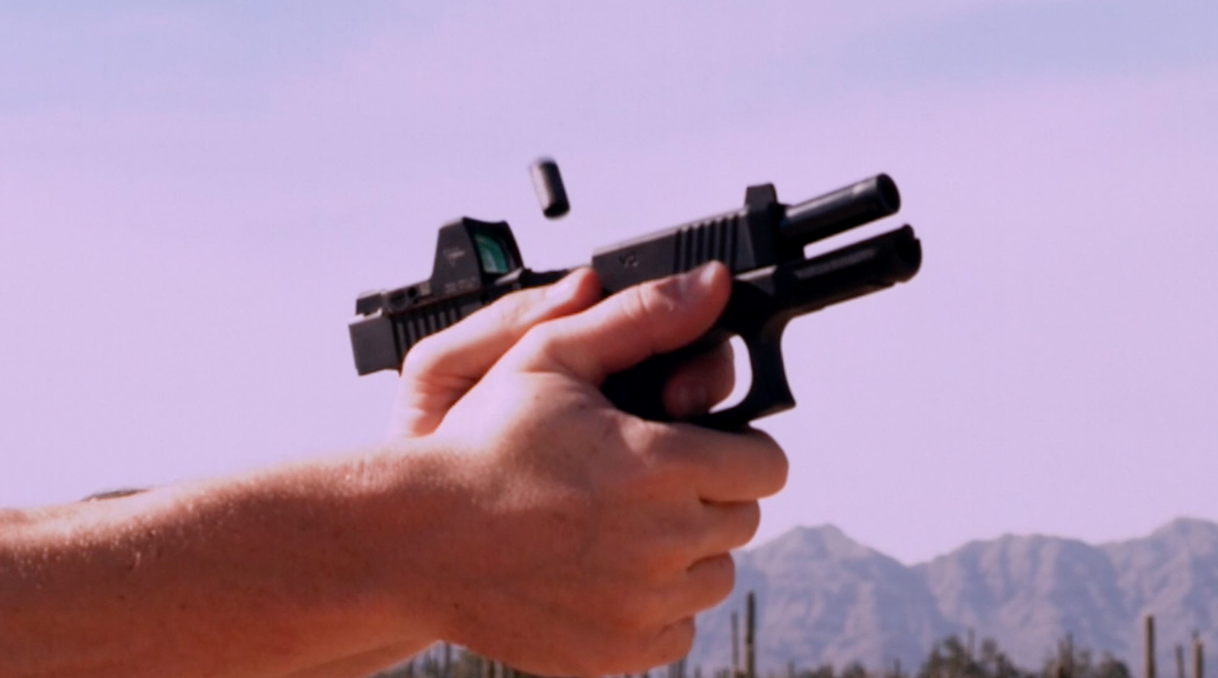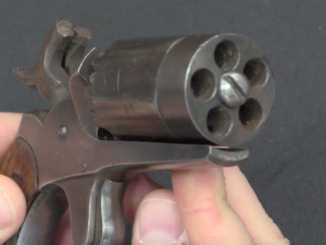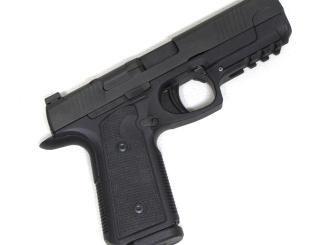RIA’s catalog page for this pistol
The Auto Mag 180 was basically the result of two guys noticing that nobody made a semiauto .44 Magnum pistol…and that they could probably do it. The men were Max Gera, a young Italian immigrant gunsmith, and his employer, gun shop owner Harry Sanford. Gera put together the core of the gun’s design in late 1969 and 1970 – a short recoil, rotating bolt pistol with an accelerator to aid extraction and a rimless case based on a cut-down .30-06 or .308 case. This would become the .44 AMP cartridge, which aimed to duplicate .44 Magnum ballistics in a rimless case.
When Sanford brought in investors to help fund to commercial production of the gun, Gera sold his share of the endeavor and left – apparently the chaos and drama of a bunch of cutthroat investors was not what he wanted to have in his life (and I can hardly blame him). Sanford and a couple other engineers completed gun pistol design, and set up a manufacturing facility in Pasadena. The first guns came off the line in August of 1971, and by May of 1972 the company was bankrupt. They had been selling the guns for far less than they actually cost to produce, in hopes of driving enough demand to get an economy of scale going in the production…but it didn’t work. Over the next 10 years, five more companies would take on the Auto Mag, each of them losing money and selling out in short order. In total, about 9,000 Auto Mag Model 180 pistol were made, 3,000 in the original Pasadena gun and the remained divided amongst the other companies. Ironically, interest in the gun would peak only after the last company gave up, when Clint Eastwood used one in the 1983 Dirty Harry film “Sudden Impact”.
Sanford passed away in 1996, but the story continues. A new company purchased the rights and the engineering to the gun in 2015, and announced new production at SHOT Show a couple years ago. Time will tell if they can be more successful than those who came before. Perhaps with modern CNC machines they can?




Aaaa Italian… that’s why it is so pretty. Who des not believe, take a look at Leno’s garage.
The exterior appearance was due to a combination of the design’s ancestry and one of Harry Sanford’s ideas.
The basic design came from the Grant Hammond automatic of 1908, that was entered in the U.S. Army pistol trials that resulted in the adoption of the Colt-Browning pistol as the M1911;
https://www.forgottenweapons.com/grant-hammond-45acp-trials-pistol/
The similarity is pretty obvious, right down to the grip angle.
Note the external cam built into the bolt to operate the locking/unlocking system. The Auto Mag replaces this with an internal cam system copied from the Schwarzlose Standart automatic of 1898;
https://www.forgottenweapons.com/schwarzlose-1898-preview/
Look at the bolt; nearly identical to the Auto Mag’s.
The “accelerator” in the frame seems to have been copied from the Finnish/Swedish Lahti automatic of 1935-37;
https://www.forgottenweapons.com/lahti-l-35-finlands-first-domestic-service-automatic-pistol/
Its exact purpose is difficult to discern. It may have been added to give the bolt an additional “kick” to begin the unlocking sequence, to deal with potential galling or even “pressure/shock welding” of the locking lugs and their recesses due to the peculiarities of stainless steel alloys.
As to who was mainly responsible for the design, while Max Gera refined it, the layout was most likely Harry Sanford’s doing. Sanford had worked for High Standard before going into business for himself, and HS had made the Grant Hammond pistols for the Army trials. They also held the Grant Hammond patents from 1910 to 1927, when they expired, and those patents were still on file at HS when Sanford worked there. I generally don’t believe in “coincidences” of that magnitude.
Gera’s main contribution was probably the Schwarzlose-type bolt-rotation system and the Lahti-type “accelerator”. As for the ventilated rib on the barrel and the sight setup, the rib was copied from the Colt Python, the front sight from the S&W N-frame “target” sights such as on the Model 29, and the rear sight from the Browning Medalist .22 target auto, beefed up substantially of course.
As for the Auto Mag not being intended for “tactical” use, if that’s so its thumb safety is a bit peculiar. It operates like a standard 1911 type, “up” for safe, “down” for fire, but if the bolt is locked back on an empty chamber by the hold open, pushing the safety down past “fire” causes a forward extension of it under the left grip panel to push down on a rearward extension of the hold open, releasing it and letting the bolt go into battery. (This is why the safety seemed a bit “loose” in Ian’s video.)
Obviously, this would make a fast reload with a loaded magazine very easy; punch the magazine button to dump the empty, slam in a loaded mag, shove the safety all the way down, and bam- you’re ready to go again.
While it might be useful in hunting, say when dealing with an obstreperous Texas porker, it’s more likely that this feature was intended for more serious forms of “social encounters”.
cheers
eon
The original Schwarzlose had an accelerator
In guns where the majority of the recoiling mass has only a very short travel
It is very useful to have a mechanism for passing as much of that momentum/energy as possible, to the much lighter bolt to help it complete it’s travel and feeding cycle.
The Brilliance of the one piece combined slide and bolt of the Browning pistols, is that it allows almost all of the recoiling mass to travel all of the way.
The mass of the recoiling barrel in a Browning style pistol is usually so small compared to the mass of the slide that it’s really not worth trying to capture and re use its momentum
And the heavier slide has the weight and momentum to more easily and smoothly complete all of its tasks, than for example the seperate bolt of a Lahti, Schwarzlose 1898 or an original auto mag.
Interestingly an accelerator is implicit in a short recoil toggle lock
The work of the cam which unlocks the toggle serves to transfer some of the momentum of the recoding barrel and slide to the toggle and the bolt
Maxim and vickers machine guns, Furrer’s range of cannon, machine guns and smgs along with Borchardt and Luger pistols, all have an accelerator implicit in the toggle action
Browning Schwarzlose and Lahti had all worked on replacements or competitors for short recoil toggle locked machine guns and pistols
Both Browning and Lahti’s machine guns and Schwarzlose and Lahti’s pistols incorporate separate explicit accelerators.
Thank you. That explains that!
😉
cheers
eon
Incidentally, I agree that the design of the accelerator looks a lot like the one in a Lahti pistol.
Oh, and as you know, the brilliance of the Browning slide doesn’t finish with the recoiling mass being in one part that travels all ofor the way (compared to the short travel of the automag’s barrel and receiver assembly)
In its fully developed form, it has to break in half before it can come off the back of the gun and hit the firer.
Something that can’t always be said about guns like Lahtis, broomhandle mausers etc, or about guns with half length slides, like the Kimball.
I suspect that the Kimball probably had some metallurgical problems in there as well, to be as bad as it was, with some even failing at as few as around 100 rounds 😐
A Browning style slide on the later AMT automags happily held the .30 carbine round that destroyed kimballs. Though why anyone would want to chamber a pistol in that round, is another matter.
Very well… And what about simple blowback with small mass bolt handguns like Smith Wesson Model 1913 or Mann pistols… What quickens the tiny bolt except the gained momentum with remaining gas…Should it be the receiver’s forward thrust through the push of running bullet creating a sudden tap against the expanding gas…
Hello
I love your channel and I am now far better informed about firearms than I have ever been before, largely thanks to your channel.
I know you have a sense of humor. For April 1st edition, could you do a show on the English Longbow, showing all your regular stuff that you detail about guns.
Hmmm… lt seems l am really getting old. Remembered as if some other comments written here.
A glitch in the matrix?
A daydream perhaps…
Probably the previous messages during the database server failure earlier today. There were more than 20 comments on the M15 pistol video and only about half of them seem to have survived.
Odd. I could swear the original intent was to have more power than the .44 magnum. Maybe from handloading? Had a friend who packed one of these Pasadena guns as a deputy sheriff, and he had to roll his own, as he complained the factory ammo wouldn’t cycle the gun. Many years later I discovered a friend was the dealer who sold it to him, and he remembered it as the first one he sold new in the Bay Area. Small world.
“They had been selling the guns for far less than they actually cost to produce, in hopes of driving enough demand to get an economy of scale going in the production”
Sounds similar to action known in economical history as dumping
https://en.wikipedia.org/wiki/Dumping_(pricing_policy)
Taking a look back at Ian’s pictures of the Schwarzlose 1898,
Schwarzlose achieved a very low bore line and ergonomic grip angle, even by today’s standards
He was willing to make better use of the striker firing arrangement to achieve a low bore line and comfortable grip than Browning was with his contemporary striker fired auto pistols.
The high in the hand bore line of the Automag, coupled with its grip being a long way forward of the hammer
Raises an interesting question about where its hammer spring is located
I’m going to have to look out the Automag patent again. I think that I have a paper copy somewhere.
It is located very much like the Webley-Scott pistols…
Did Ian ever post more than the intro to the 1898 Schwarzlose pistol?
Interview with Max Gera:
http://www.amtguns.net/articles/bruce-stark/max-gera-interview/
Gera says that the accelerator was necessary to get the gun to cycle
It also needed a spring to encourage the bolt to rotate and lock
In the interview, Gera says that he has realised that the bolt was too light to cycle reliably
In his experiments in the 19 80s, he used a cam groove in the bolt rather than hollowing the bolt out,
Gera also suggests having something like the heavy bolt carrier of an AR15, slamming forward to rotate and lock the bolt
Automag patents
http://www.amtguns.net/amt-information/patent/
maybe if the gun were changed to emulate the m16 BCG with a gas assist it probably would have solved all the issues, with a side cocking handle and 2 piece bolt carrier and bolt